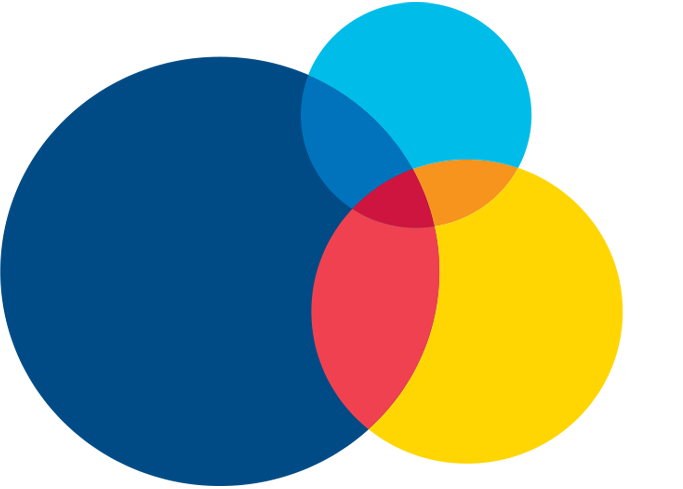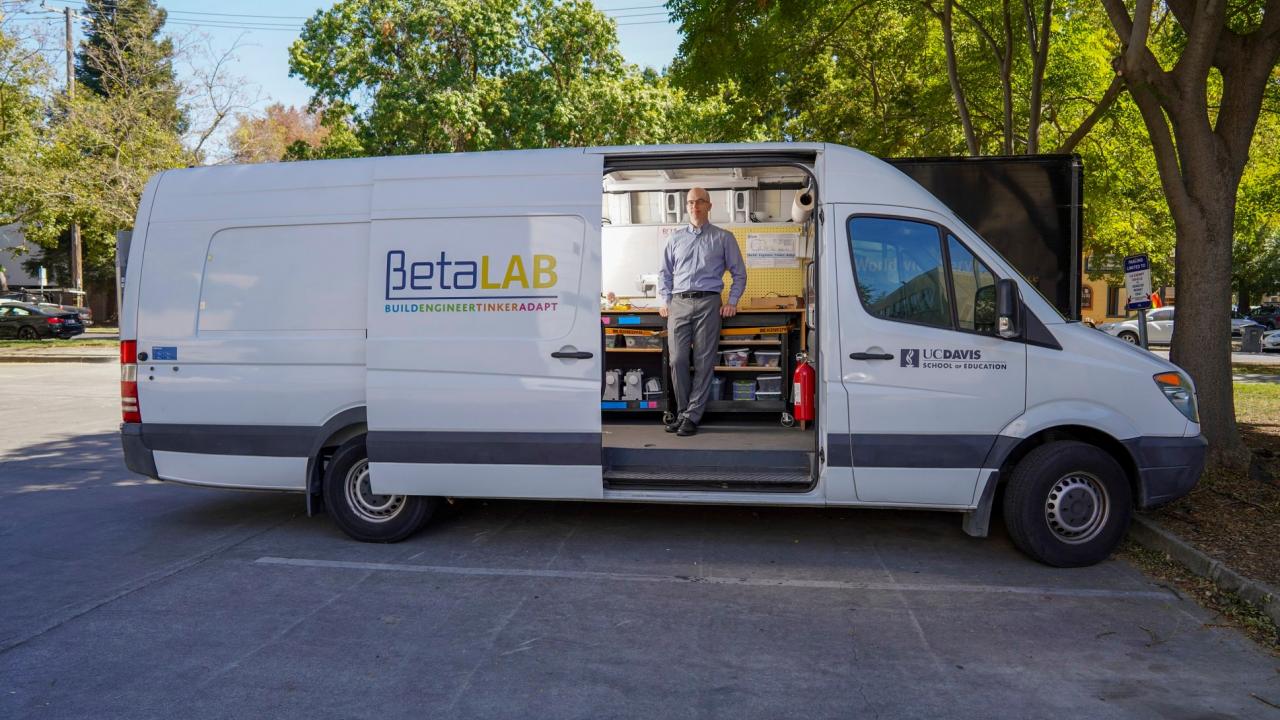
Reflections on Community Engaged Learning During a Pandemic
By Lee Martin, Associate Professor, School of Education
I want to share a bit about my experience leading a community engaged learning experience in 2020 and the evolution of that work through the COVID-19 pandemic. During this time, I was a Community Engaged Learning Faculty Fellow (CELFF) with Public Scholarship and Engagement. With everything disrupted, it first seemed like it was terrible timing for my fellowship year, but in retrospect, it was a gift to be connected to such amazing colleagues during such a trying time.
Winter 2020
Broadly speaking, the goal of my research group – Beta Lab – is to design and investigate maker learning environments that equitably promote the development of adaptive expertise and STEM identity. Maker-centered education provides youth with opportunities to envision, design, and build hands-on projects of their own imagining, using both high-tech and low-tech tools and materials. Many, myself included, are excited by the potential of making to reinvigorate STEM learning environments. My team and I designed a mobile maker space in a van and developed a set of working pedagogical principles that focus on meeting students where they are – geographically, cognitively, and affectively. Since 2016, I have led a community engaged learning experience within Beta Lab, where undergraduates work as mentors with youth in our programs (funded through UC Links.)
In winter of 2020, things were in full swing. I had a handful of undergraduate mentors enrolled in a 2-unit course and working with local youth on maker projects, assisted by lead undergraduate mentor, Ann Rainey, and graduate student, Jade Lee. Students had completed skill-building activities in the fall at our high school site and were beginning to envision and design longer-term, more ambitious projects. At our elementary after school site, students were learning to work with sensors, motors, lights, and block-based programming, as well as cardboard and decorating supplies to design and build interactive robotic “pets” for a robot petting zoo. This was new territory, and exciting for all of us as we learned how to use the technology and provide good mentoring. A central commitment in all the work with youth was (and is) an effort to center youth assets – their interests, skills, ideas, ways of interacting, and other personal and community funds of knowledge – and to build activities that allow youth to bring their unique set of assets to the table.
COVID-19 Arrives
When COVID-19 closed in-person activities, both of our sites shut down abruptly and I had little idea what would come next. All of our activities and pedagogies were built on hands-on, in-person, co-present making. How could we continue without any of that in place?
Two things helped me move forward. The first came from my home life – I have two children, aged 10 and 1½ at the beginning of the pandemic, and when school and daycare shut down, it was a big adjustment. There was a sudden vacuum in meaningful educational activities in their lives. At the same time, my inbox was deluged with emails from every educational institution I had ever interacted with, chock full of activities to do with my kids at home. While I appreciated the resources and the show of solidarity, I quickly realized this approach was not workable for my family. My wife and I were both working full time (now with zero childcare for our two children) and we had neither the time nor the capacity to navigate these resources; to comb through dozens of possibilities, find the right materials, motivate our son, help him through sticking points, and so forth. I thought of all the kids we work with in Beta Lab, most of whom live in much less highly-resourced homes, whose parents might be far busier and more overtaxed than we were. Was there anything Beta Lab could offer?
The second motivation came from regular conversations with my CELFF colleagues. At a moment when everything seemed broken and impossible, I was able to reconnect with the reasons I find this kind of work important and satisfying. My conversations in that group helped me differentiate between what was possible in the short term and the longer term, and how I could build back toward my goals. I was also able to remember that our pre-pandemic efforts were far from perfect, so this disruption was also an opportunity to rethink.
Spring 2020
In spring 2020, it was impossible to have meetings with children, in-person or virtually. The plan instead was to develop kits and activities that kids could complete at home on their own time. Ann, Jade and I developed a list of basic, low-cost materials for make-at-home kits. We wanted to serve everyone and did not want to make assumptions about what families would have at home.
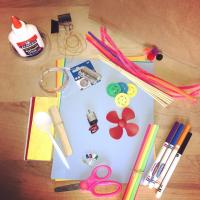
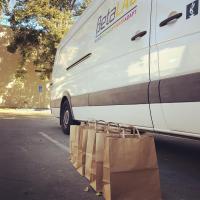
We formed a partnership with the Boys and Girls Clubs of Greater Sacramento. Using funding from UC Links and my 2017-2018 Chancellor’s Fellowship, we purchased supplies for 100 kits that the Boys and Girls Club then assembled and delivered. My class this quarter consisted of some of the usual activities – reading and discussing learning theory and maker education – but the assignments were different. Rather than in-person mentoring, the students each developed at-home making activities, complete with printable instructions and a YouTube video. Printed activity sheets were sent home to 100 Boys and Girls Club club families, to support anyone without reliable internet. While these one-way efforts did not match our ideal vision of pedagogy, it was an opportunity to rethink what was possible, embrace new approaches, and work to put something of value out into the world.
Fall 2020
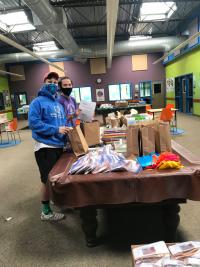
Over the summer, I worked with the Boys and Girls Club to plan synchronous, distanced mentoring sessions for fall quarter. A new cohort of undergraduate mentors joined the class and got to work on the logistics of volunteering (background checks and volunteer training) along with reading and discussions about maker education, mentoring more broadly, and equity in education. We sent a new batch of kits to the Boys and Girls Club to deliver to families. Initially, we hoped for six weeks of synchronous making sessions with youth, but an unexpected storm of red tape delayed the start multiple times, until we only had two synchronous sessions. I was hugely disappointed at first, and I remember venting my frustration to my CELFF colleagues. But the undergraduates’ reflections on their experience helped me appreciate the value in what we did accomplish, and in particular the importance of a small class experience in the midst of pandemic isolation.
Winter 2021
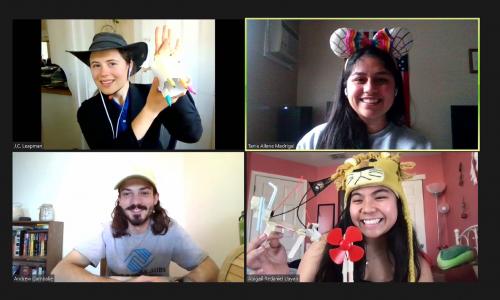
Finally, things were starting to move a little bit more smoothly. Some more bureaucratic hiccups delayed the start of mentoring again, but we were able to complete four weeks of activities with three groups of upper elementary-age youth. A new graduate student, J.C. Leapman, joined the project, providing fresh insight and perspective. End-of-quarter reflections from undergraduate mentors were particularly enlightening. One said of her experience.
“Being a mentor for the Beta Lab this past quarter provided me a change of pace from online school and work that I desperately needed. I appreciated being able to interact with a different age group while working alongside peers who share the same passion for education as me. Throughout this experience, I have expanded my knowledge in hands-on learning, grown my appreciation for educators working during a pandemic, and continued to value the creativity of students.”
Spring 2021
As I write this post here in late spring, now more than a year into the pandemic, the systems we have set up are finally working as we had envisioned them. We have another great group of undergraduate mentors, many of whom returned from winter quarter. We anticipate having full six weeks of mentoring, and because many of the youth have returned as well, we built on the work of the winter to develop more technically sophisticated activities, centered on building tabletop games that incorporate electronic components.
Looking forward
The relative smoothness of spring 2021 is bittersweet, as this will be the last quarter Beta Lab runs in this fashion. Looking ahead, we plan to return to in-person mentoring, making use of our mobile maker van again, and embracing a wider set of possibilities for student projects. With so much effort, what was gained and what was learned?
I know I will take away many lessons from this year, but as we are only starting to adjust to a new normal, it is hard to know what will emerge as most central. For now, two ideas stand out as particularly important. First, in the CELFF program, I developed new tools to foreground issues around race, power, identity, and positionality in community work. I believe that the shifts I made in my teaching led to better discussions and, ultimately, more trust and openness in our class discussions. Despite the limitations of Zoom meetings, we had some of the best class sessions ever this year. Students really dug into what it means to be an educator and how they can become the educator they want to be.
Second, I see the benefits of stepping back. Feeling overwhelmed in my personal life led me to rely more heavily than I ever would have dared on my student employees, both graduate and undergraduate. I was lucky to have brilliant and capable students, but I think the lesson transcends their unique gifts. When I leaned more on student leaders, it opened more space for the other undergraduate mentors to take ownership over their roles, to the benefit of all.
I hope I can take these lessons forward into the post-pandemic future.
All blogs are the personal accounts and opinions of the individual writers and do not necessarily reflect the those of Public Scholarship and Engagement or UC Davis.
